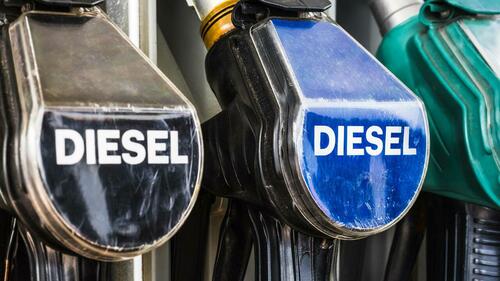
By Josh Owens of Oilprice.com,
Europe is buying more diesel from the United States and Saudi Arabia in preparation of the EU ban on seaborne imports of Russian refined products, yet Europe still remains the biggest buyer of Russian diesel, data compiled by Anadolu agency showed on Thursday.
The EU will ban - effective February 5 - seaborne imports of Russian refined oil products and around 1 million barrels per day (bpd) of Russian diesel, naphtha, and other fuels need to find a home elsewhere if Moscow wants to continue getting money for those products.
More than half of those Russian fuel exports to the EU are diesel. Ahead of the embargo set to kick in in ten days, Europe continues to be the biggest buyer of Russian diesel, and it has been stocking up on Russian supply in recent months ahead of the ban.
In December, for example, Russia’s diesel exports surged to a multi-year high of 1.2 million bpd, of which 720,000 bpd was destined for the EU, according to estimates in the latest Oil Market Report by the International Energy Agency (IEA).
Europe is still estimated to import large volumes of diesel, of around 600,000 bpd, weeks before the embargo comes into effect. After February 5, the diesel markets and the product flows globally are set to change, with Russia looking to place its refined products elsewhere and Europe hauling in more supply from the United States, the Middle East, and Asia, analysts say.
This month, Europe is expected to receive the highest volumes of diesel and gasoil from the U.S. in two years, per Vortexa data cited by Argus.
“Europe will enter the post-Russian diesel world relatively well supplied. A rush for Russian diesel imports in Q3 2022 combined with a warmer European winter and well supplied natural gas has softened the diesel supply shock and panic buying witnessed in October 2022,” Pamela Munger, Senior Market Analyst at Vortexa, wrote in an analysis last week.
“Unlike the crude markets, where many European refiners started in advance of the Russian crude ban by testing non-Russian crudes, the cessation of diesel exports to its core markets could have significant impact on Russia’s energy flows, possibly shutting in refinery operations as Russia looks toward only a few regions for export outlets.”
By Josh Owens of Oilprice.com,
Europe is buying more diesel from the United States and Saudi Arabia in preparation of the EU ban on seaborne imports of Russian refined products, yet Europe still remains the biggest buyer of Russian diesel, data compiled by Anadolu agency showed on Thursday.
The EU will ban – effective February 5 – seaborne imports of Russian refined oil products and around 1 million barrels per day (bpd) of Russian diesel, naphtha, and other fuels need to find a home elsewhere if Moscow wants to continue getting money for those products.
More than half of those Russian fuel exports to the EU are diesel. Ahead of the embargo set to kick in in ten days, Europe continues to be the biggest buyer of Russian diesel, and it has been stocking up on Russian supply in recent months ahead of the ban.
In December, for example, Russia’s diesel exports surged to a multi-year high of 1.2 million bpd, of which 720,000 bpd was destined for the EU, according to estimates in the latest Oil Market Report by the International Energy Agency (IEA).
Europe is still estimated to import large volumes of diesel, of around 600,000 bpd, weeks before the embargo comes into effect. After February 5, the diesel markets and the product flows globally are set to change, with Russia looking to place its refined products elsewhere and Europe hauling in more supply from the United States, the Middle East, and Asia, analysts say.
This month, Europe is expected to receive the highest volumes of diesel and gasoil from the U.S. in two years, per Vortexa data cited by Argus.
“Europe will enter the post-Russian diesel world relatively well supplied. A rush for Russian diesel imports in Q3 2022 combined with a warmer European winter and well supplied natural gas has softened the diesel supply shock and panic buying witnessed in October 2022,” Pamela Munger, Senior Market Analyst at Vortexa, wrote in an analysis last week.
“Unlike the crude markets, where many European refiners started in advance of the Russian crude ban by testing non-Russian crudes, the cessation of diesel exports to its core markets could have significant impact on Russia’s energy flows, possibly shutting in refinery operations as Russia looks toward only a few regions for export outlets.”
Loading…





